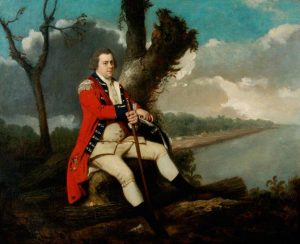Many visitors to the Straits of Mackinac are aware of the events of June 2, 1763, when a group of 400 Ojibwa men captured the British fort of Michilimackinac through a skillful surprise attack. The Ojibwa attack, which initially took the form of a seemingly-innocent game of baggatiway in honor of King George III’s birthday, ended in just minutes, with 15 soldiers dead and commanding officer Captain George Etherington held prisoner. The loss of Michilimackinac was undoubtedly the low point of Etherington’s life, but this resourceful officer ultimately enjoyed a long career in the British military.

Born in Delaware around 1733, Etherington first entered the British army as an enlisted man before receiving a commission in the 60th, or Royal American, Regiment in 1756. He served with the 60th through the Seven Years’ War, and was promoted to captain in 1759. Along with the rest of the regiment, Etherington received orders to take up station at former French forts around the Great Lakes in 1761. He assumed commanded of Michilimackinac in 1762. He and his garrison were taken completely by surprise when the Ojibwa attacked the fort a year later. Etherington and his subaltern, Lieutenant William Leslye, were actually outside the fort watching the game, and as such were among the first captured. He and the other survivors were ransomed from the Ojibwa by the local Odawa, and were shipped to Montreal as prisoners later in the summer.
Despite the loss of his command, Etherington suffered few consequences, and continued to serve with his regiment, eventually receiving a promotion to major in 1770. He briefly served as the commanding officer of Fort Niagara in New York before joining the 60th in the Caribbean. There, he was instrumental in signing a peace treaty between the British and the indigenous Caribs living on the island of St. Vincent in 1773. However, lingering tensions with the Carib people, as well as the outbreak of the American Revolution, prompted Etherington to take command of the military forces on St. Vincent in 1777. Etherington, by then a lieutenant colonel, was chosen in part due to his perceived good relations with the Caribs.
Etherington’s tenure on St. Vincent was plagued by ongoing disputes with the island’s civil governor, Valentine Morris. These tensions exploded when French forces arrived to attack the island in June 1779. Over Morris’ objections, and with only a few soldiers at his disposal, Etherington surrendered the island to the French without resistance. Unlike the loss of Michilimackinac, the surrender and Morris’ subsequent complaints prompted an official inquiry concerning Etherington’s conduct. However, Etherington’s court martial fully acquitted him of all charges, and he remained in service with the 60th Regiment, eventually being named its colonel in 1782. He retired from the army in 1788, having maintained a good reputation as an officer throughout his career despite losing two commands to surprise attack.
Although his time at Michilimackinac was short, Etherington’s role in the 1763 attack lodged him permanently in the history of the Straits of Mackinac. Today, a street in Mackinaw City is named after him, and research continues concerning his career before and after the attack, largely thanks to the efforts of Dr. Todd Harburn, upon whose work this post is based.









